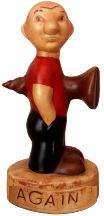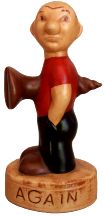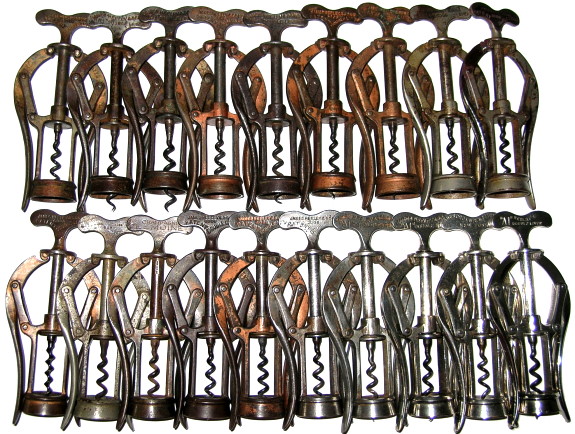 |
 The Virtual Corkscrew Museum's Weekly Newspaper |
 |
 |
 The Virtual Corkscrew Museum's Weekly Newspaper |
 |
|
Sunday, November 11, 2007 |
Number 488 |
Heeley's A-1
Evolution
In 1880, William Burton Baker was issued British Patent No. 2950 for his "Improvements in Corkscrews." Baker's patent was the first double lever corkscrew. To use the corkscrew, the two levers are placed in the down position and the worm is turned into the cork. As the worm turns, the arms rise. Once fully inserted, pushing the levers down will extract the cork.
Baker's corkscrew was produced by James Heeley & Sons of Birmingham. Heeley really didn't like Baker's design because it did not function smoothly and was clumsy. The arms or levers meet a collar at the top of the shank and there is too much play in them. This sometimes causes the upper portion of the arm to crack. Heeley found the concept worked better by attaching the arms to a collar which would ride on the shaft. In 1888 he received a patent for this. The Baker design was abandoned very early and replaced with Heeley's improvements in the A-1 Double Lever. The A-1 was produced well into the 20th Century.

Heeley's A-1
The usual markings on the handles of these corkscrews are JAMES HEELEY & SONS 6006 PATENT DOUBLE LEVER and JAMES HEELEY & SONS LD. "A1" DOUBLE LEVER.
Marking with patent number
Marking with product name (A1)
A much simpler Heeley Mark
Advertising
Less common are the Heeley A-1 corkscrews with advertising.
Abercrombie & Fitch on one side and MADE IN ENGLAND on the other.
From Wikipedia: "Abercrombie & Co. was founded by David Abercrombie on June 4, 1892. By 1900, Ezra Fitch joined into the company and so Abercrombie & Fitch Co. was formed. Partnership between the founders did not end well. Abercrombie wanted to continue selling professional gear to professional outdoorsmen while Fitch wanted to expand its appeal to the general public. The two quarreled frequently even as the company grew increasingly successful. In 1907, Abercrombie sold his share in the company to Fitch and returned to manufacturing outdoor goods. Fitch continued the business with other partners and was, for the first time, able to direct the company in a manner to his pleasing."
John Roaf Buss & Sons Ltd. was located at 64 & 66 King Street, Manchester.
They were ironmongers from 1856 to 1963.Invercauld Scotch (from William Grant & Sons founded 1886)
W. E. Johnson & Co., Liverpool
Big Ben Scotch on the handle
James Denman & Co., 5 Exchange St., Manchester on the levers
Two different Champagne Lemoine
Lemoine Champagne is found on a lever with Big Ben Scotch on the opposite lever
Variations
In addition to plating differences, additional variations can be found in the A-1.
The short hinge machined in one piece is the earliest version
of the Heeley and the two piece is the later production.The A-1 on the left advertises Lemoine Champagne. The neck at the bottom of the frame is larger than the example on the right to accommodate larger diameter bottles. Also note the web helix.
Very uncommon are the A-1 corkscrews with a web helix
A-1 in the original box
The "Optimus" was a German version of the Baker patented
produced by Ernst Demmler in the early 20th Century.
Lemoine Champagne
The Lemoine A-1 plus two additional Lemoine advertising corkscrews
The shank of the worm on the Lemoine A-1 is marked
Why "The Monk" on the back of the knife? Le Moine is French for the Monk!
|
©2007 Don Bull, Editor |